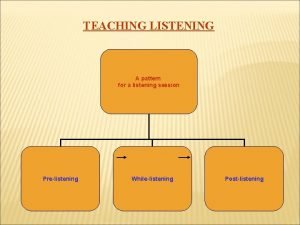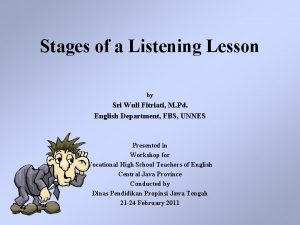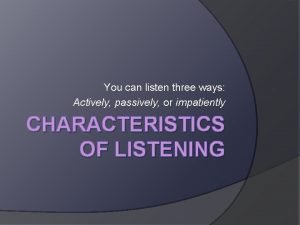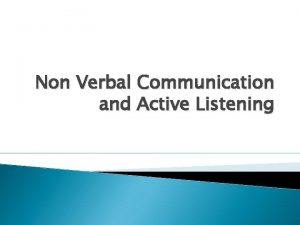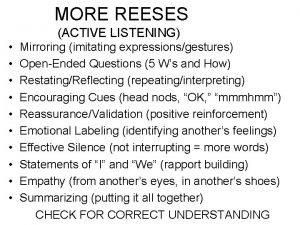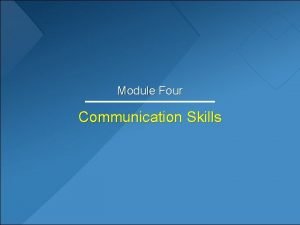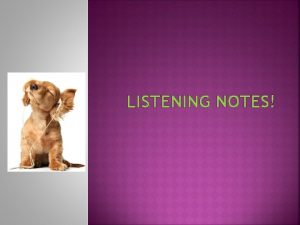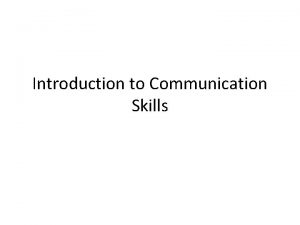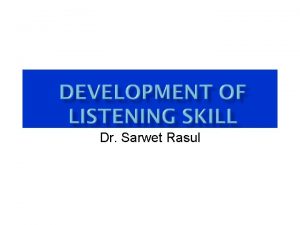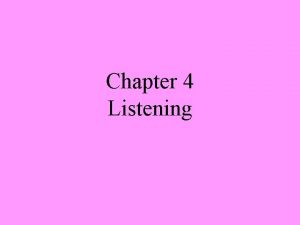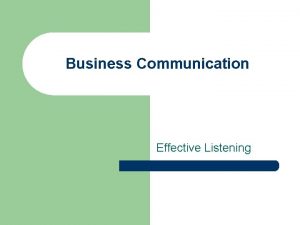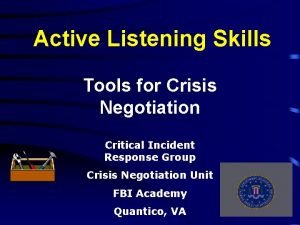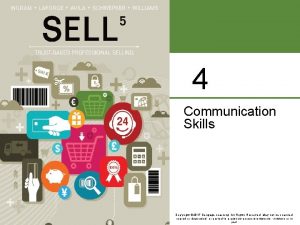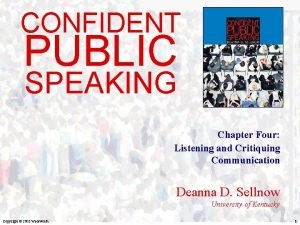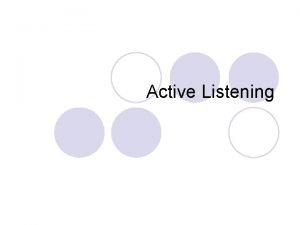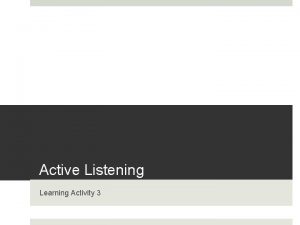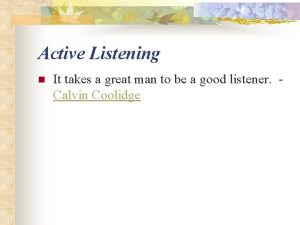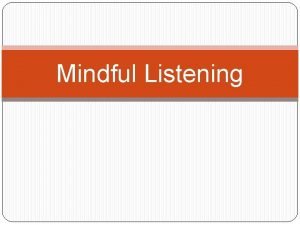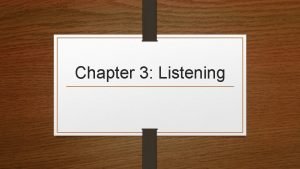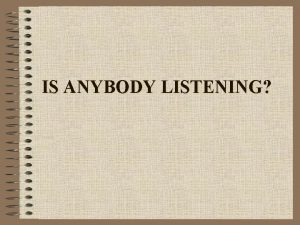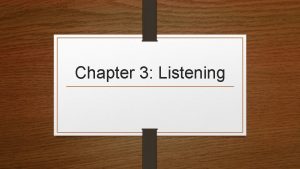LISTENING NOTES QUICK INFORMATION Listening is active takes






















- Slides: 22

LISTENING NOTES!

QUICK INFORMATION! Listening is active, takes hard work, and it can be learned. Hearing is passive, only takes in sound, and takes little effort. We remember only 25% of what we hear. We can listen to about 600 -800 words per minute and speak only 120 -180 words per minute, we need to learn how to focus our minds and listen better.

Why is listening important? Listening will help you in… • School • Relationships • Social groups & organizations • Making informed decisions • On the job

Hearing- sense that allows you to perceive sound; physical act- only requires reception of sound waves Listening- mental process that requires concentrating on sound, deriving meaning from it, and reacting to it

Listening Process

You first respond emotionally, then intellectually. Then you decide how to respond. Steps in the listening process Your knowledge, attitudes, values, beliefs and self-concept influences your perception. Your own needs, interests, attitudes, and knowledge affects your choice to pay attention. Not everyone hears the same way. Men actually prefer certain frequencies. Hearing The reception of sound. Choosing Understanding Responding Your reaction to the message. It can be emotional and intellectual. Deciding what the message means to you. The act of choosing to focus attention on the message. Definition of listening: It is a physical and psychological process that involves choosing to listen, understanding, and responding to symbolic messages from others.

Listening for fun. Used in social situations like concerts, plays or sporting events. Used when listening to lecture in class. Ap pr ec al ia itic r C Used when you need to remember tiv e Goal is enjoyment and helps a person to relax. Used when listening to announcements or getting directions. something important. Listening to enjoy or appreciate a speaker’s message or performance. Listening to comprehend ideas and information in order to achieve a specific purpose or goal. Kinds of Listening to understand, participate and enhance a relationship. Listening to understand, analyze, and evaluate messages. Usually used in interactions between two people or a small group. c hi t a Goal is to develop understanding and appreciation of the meanings & feelings of sender. You try to put yourself in another person’s place, but not necessarily agree with them. Em p De Used when receiving and evaluating persuasive messages. lib er at ive Use when you must make decisions. It should make you think.

TYPES OF LISTENING § § § Appreciative listening for enjoymentrequires, little mental involvement (music, TV, radio); Listening for informationrequires more concentration; expected to retain info. Critical listening- listening for information as well as analyzing and evaluating it (watch the news; debate)

§Discriminative listening with attention to details that give you clues to the speaker’s emotion or state of mind Empathic listeninghighest level; requires concentration, retention, and judgment as well as empathy §

Barriers to Listening

Noise – Internal and external distractions Examples: outside sounds, distracting thoughts Barriers – Blocks listening/understanding. Unfamiliar language, anger, attitudes, biases, needs, beliefs, fear, hearing problems, tuning out, stress, ignorance, prejudices, tired. Memory – 3 types Immediate – Recalling information for a brief period of time. Short term – Recalling information for carrying out a routine or daily task. Long term – Recalling information from past experience.

Barriers keep you from understanding the speaker’s message They create interference There are external distractions-outside of yourself (sirens, spider on wall, loud truck, construction, etc. ) There are internal distractions- inside your mind (thinking about other things, planning your weekend, daydreaming, etc. )

Your desire to talk- most people would rather talk than listen; planning our response Personal biases- being for or against an idea and letting that opinion form the basis of your thinking (adults about teenagers; culture- accents) Conflicting demands- doing too many things at one time; can’t give all your attention on one thing if it’s focused on two or three (eating and watching TV while talking on phone)

SEVEN SINS OF LISTENING 1. Pseudo-listening- appearing to listen but actually paying no attention. 2. Self-Centered Listening- focusing on what we are waiting to say rather than on what is being said to us. Selective listening-listening to only those parts of a message that are of immediate interest. Fill-in Listening-using assumptions to fill in gaps about part of a message that we have not attended to. 3. 4.

SEVEN SINS CONTINUED. 5. Defensive listening- hearing hostile messages not intended by the speaker. 6. Insulated Listening- choosing not to hear parts of a message that make us uncomfortable. 7. Reconstructive Listening- transforming a new message to conform with prior, more familiar message.

1. Tuning out dull topics. Many listeners decide early on that a topic is simply not interesting. However, it has been said that there are no uninteresting subjects, only uninterested people. Don’t be a lazy listener! Remedy – Listen for something you want or need. You can always find something of value in what another person is saying. 2. Faking attention. It’s no sin to be courteous, but sometimes we take manners to an unfortunate extreme. When we find someone’s conversation boring, but are too polite (or afraid) to risk offending the person, we pretend to pay attention, though our minds are a thousand miles away. Remedy – Sincerely pay attention. Lean forward, maintain good eye contact, react in a natural way with smiles or nods, ask questions. Good listening is not passive – it takes energy to listen!

3. Yielding to distractions. Outside noises or movements often affect our concentration. A window drops shut, someone sneezes, a book falls to the floor. All too often, we give our attention to the hubbub of activity around us instead of the speaker in front of us. Remedy – Choose a suitable environment to have conversations. Learn to ignore the distractions and don’t become a distraction. 4. Criticizing delivery or physical appearance. Many people abandon their good listening habits when they become overly critical of the speaker’s physical appearance or delivery. Regardless of who the speaker is, the content of his/her message is always far more important than the form of his/her delivery. Remedy – Pay attention to what is said, not how. Be generous enough to overlook difficulties the speaker is having.

5. Jumping to conclusions. Be patient. We often think that we know what a person is going to say before they have even finished speaking. Occasionally, we are biased toward a speaker and so we close our minds to the speaker’s message before we have heard it in its entirety. Remedy – Don’t judge before you have heard the whole message. Hear the speaker out. Understand their point of view fully before accepting or rejecting it. 6. Interrupting. Do you spend most of your listening time actually listening or do you spend it thinking about what you want to say? Interrupting someone is an almost certain sign that you don’t know or care about what the other person is saying. Remedy – Take time to think about what is being said before responding. Wait for an opening. Put yourself in their shoes.

7. Overreacting to emotional words. We will react from time to certain words or phrases that push our “hot buttons. ” At such times, we might experience a strong emotional reaction that blocks out your ability to listen. We might let our thoughts wander on to other subjects, blocking the speaker’s message from our minds, or we might start to lay plans to trap the speaker in some way. Remedy – Stay calm. Finish listening. Don’t let a mere symbol for something stand between you and learning. Think before responding.

Active listener – The listener participates fully in the communication process. You listen attentively, provide feedback, and strive to understand remember messages. Passive listener – The listener does not actively participate in interactions. They think they can absorb information even when they do not contribute to the interaction. They place the responsibility for successful communication on the speaker. Impatient listener – Short bursts of active listening are interrupted by noise and other distractions. They intend to pay attention, but allow their minds to wander.

Apply what you hear to yourself. Relate the information to your personal experience. Use your own knowledge to understand new information. Imagine using the information in the future. Think as you listen Summarize and review throughout a presentation. Use associations Picture things in your mind – “see it” Use mnemonic devices – rhyme, acronym, etc. Take notes Do not write every word – paraphrase; focus on key phrases. Use the same method for taking notes. Give feedback Show others you are listening with body language and eye contact and ask questions.

HEALTHY LISTENING PRACTICES Free your mind (Don’t judge or criticize) Put aside distractions (position to listen) Don’t interrupt (mouth shut) Be aware of your body language Clarify (understand, don’t assume) Ask questions (open-ended) Reflect and respond (mirror and encourage)
 Active listening passive listening
Active listening passive listening What is post listening stage
What is post listening stage Stages of a listening lesson
Stages of a listening lesson Quick find algorithm
Quick find algorithm Quickchek menu
Quickchek menu 3 to 8 decoder truth table
3 to 8 decoder truth table Membrane structures that function in active transport
Membrane structures that function in active transport Primary active transport vs secondary active transport
Primary active transport vs secondary active transport Deliberative listening definition
Deliberative listening definition Insulated listening definition
Insulated listening definition Listening vs hearing
Listening vs hearing Active listening verbal and nonverbal
Active listening verbal and nonverbal Mirroring active listening
Mirroring active listening Cuaderno
Cuaderno Discriminative listening
Discriminative listening Communication skills introduction
Communication skills introduction Morepies active listening
Morepies active listening Rasul session
Rasul session How would one use ears for utilizing spare listening time
How would one use ears for utilizing spare listening time Difference between effective and ineffective listening
Difference between effective and ineffective listening Mirroring active listening
Mirroring active listening Trust based sales communication
Trust based sales communication Listening to and critiquing public speeches
Listening to and critiquing public speeches

